Songs Illustrated by Tuck Part I of II
The postcard world was rocked to its very foundation when the bombs fell on London in the winter of 1940. Those bombs destroyed the warehouses of art, paper stock, machinery, ink and the corporate records of the Raphael Tuck and Sons, By Appointment, “Art Publishers to Their Majesties the King & Queen.”
Thanks, has gone to the heavens from generations since then because Tuck was a very successful company and their products reached every corner of the earth. The postcards made by Tuck number in the many millions, and today the hobby we all enjoy is very different because of what happened that December night.
Two characteristics of the Tuck company were diversity and perfection. From both the arts and the sciences, Tuck made postcards to satisfy every curiosity and every taste. Tuck hired the best artists, photographers and print professionals to make those postcards. And, much of their professional time was devoted to making postcards that illustrated the ballads, ditties, poems, hymns and songs that were so much a part of British, Irish, and American society.
This checklist is designed to help collectors of Tuck’s Illustrated Songs series. It includes the basic information that identifies the fifteen sets – 90 cards in total – that qualify under the definition that the illustration must include at least a line from a ballad, poem, or song. The list also includes a representative sample from each set. The example is enhanced by a very brief history that we hope will be a challenge for collectors to do additional research that would – how is it said? – “… fill-in the blanks.”
PostcardHistory.net is proud to present this checklist to our readers; enjoy!
Tuck’s Illustrated Songs
Set #1152
Illustrated Songs Series I (6 cards) 1903
Artist: Not Credited
- Auld Lang Syne.*
- Comin’ Thro’ The Rye.
- Comin’ Thro’ The Rye.
- Comin’ Thro’ The Rye.
- Comin’ Thro’ The Rye.
- Darby and Joan.
*Auld Lang Syne. The original lyrics, written by Robert Burns in 1788, were a poem of remembrance of things past. First set to the tune of a traditional folk song, it has become well known in many English-speaking countries and is sung to bid farewell to the old year.
Set #1158
Illustrated Songs Series II (6 cards) 1905
Artist: Not Credited
- Killarney –“By Killarney’s Lake*
- Killarney – “No place else can charm the eye…
- Killarney – “Virgin there the green grass grows…
- Killarney – “No place else … with such bright and varied tints.”
- Killarney – “Virgin grass. Ev’ry morn…
- Killarney — “Mountain paths and woodland dells
*By Killarney’s Lake. The full title of this Irish lilt by Edmund O’Rourke is By Killarney’s Lakes and Fells. The lyrics tell the story of the emerald isles; and the song provokes memories of the bounties of nature that fill the land with beauty.
Set #1159
Illustrated Songs Set III (6 cards) 1904
Artist: Not Credited
- Auld Lang Syne
- Gather Ye Rosebuds While Ye May
- The Blue Bells of Scotland
- The Jolly Young Waterman
- The Lost Chord*
- The Swanee River
*The Lost Chord. This song was composed by Arthur Sullivan in 1877 at the bedside of his brother Frederic during Fred’s last illness. Fred Sullivan was a well-liked actor and singer in the London theater. The manuscript of the song is dated January 13, 1877; Fred Sullivan died five days later.
#1160
Illustrated Songs Series IV (6 cards) 1904
Artist: Not Credited
- Caller Herrin’ Buy My Caller Herrin*
- Down the Vale
- My Heart’s in The Highlands
- The Meeting of the Waters
- The Old Folks at Home
- Wha’ll Buy My Caller Herrin’?
*Caller herrin. “Caller” is a Scottish word for fresh fish, particularly herring. It was the traditional cry of fishwives in East Anglia, who carried creels of the daily catch from door to door, but just as often stood on street corners. Nathanial Gow, a violinist and bandleader wrote the song about 1798. It is one of his best-known tunes.
#1362
Illustrated Songs Series V (6 cards) 1904
Artist: Graham Hyde
- He Promised to Buy Me a Bunch of Blue Ribbons.*
- Idle Words.
- I Dreamt That I Dwelt In Marble Halls.
- One Morning, Oh! So Early.
- The Devout Lover.
- Will He Come?
*He Promised to Buy Me a Bunch of Blue Ribbons. This lilt was written to honor the wives whose husbands never lived-up to their promises. The phrase originally appeared in the nursery tune, Oh dear, what can the matter be? It is thought to go back as far as 1770.
#6004
Popular Songs Illustrated (6 cards) 1904
Artist: Geo. Belcher
- Come Where My Love Lies Dreaming
- How Happy Could I Be with Either Were
- I Will Not Ask to Press That Cheek
- Oh! That My Tongue Could Utter the Thoughts That Arise in Me
- Take Back the Heart*
- The Flight of Ages
*Take Back the Heart. This traditional song was written in 1891 by Stephen Shameon. It was meant to be a soulful lament for those who were recently forlorned. George Belcher, one of Britain’s most loved cartoonist, turned it into a butchershop joke.
#6014
Songs Illustrated (6 cards) 1904
Artist: Lance Thackeray
- For You
- I Fear No Foe*
- It’s the Nasty Way ‘E Says It
- Never Introduce Your Donah To A Pal
- The Last Watch
- The Return of the Swallows
*I Fear No Foe. Written by Edward Oxenford is still sung today at sporting events. Originally it was meant to show one’s loved one how brave a man could be, but it lost that meaning when Scottish footballers started using it as a chant, circa 1890.
#6015
Songs Illustrated (6 cards) 1904
Artist: Lance Thackeray
- Beloved, It Is Morn
- Crossing the Bar*
- Oft In the Stilly Night
- The Cake Walk
- The Little Stowaway
- When Love Is Kind
*Crossing the Bar. Written in 1889 by Alfred ‘Lord’ Tennyson as a poem, it was meant to be a hymn for Christian worship that assured parishioners that faith in God would always afford them comfort and understanding. Artist Lance Thackeray saw it differently.
#6091
Popular Songs Illustrated (6 cards) 1908
Artist: Geo. Belcher
- Fain Would I Change [That Note]*
- Home They Brought Her Warrior Dead
- I Watch for Thee
- “O Dry Those Tears!”
- The Spring My Dear Is No Longer Here
- When the Corn Is Gathered In
*Fain Would I Change. “Fain Would I Change That Note,” was first sung by the theatre crowd to illuminate the theme of how love changes people; some for the better, others for the worst. George Belcher looked at love from the better side and made cartoons that helped his readers see the obvious.
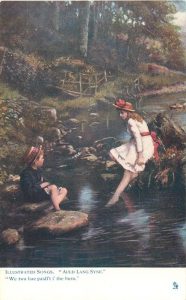

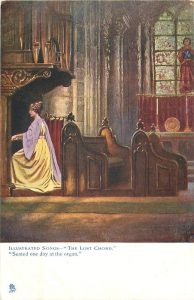

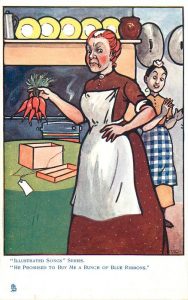

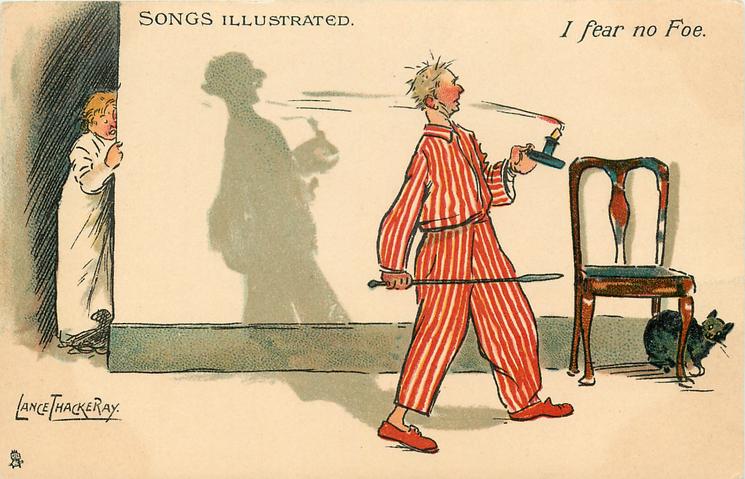
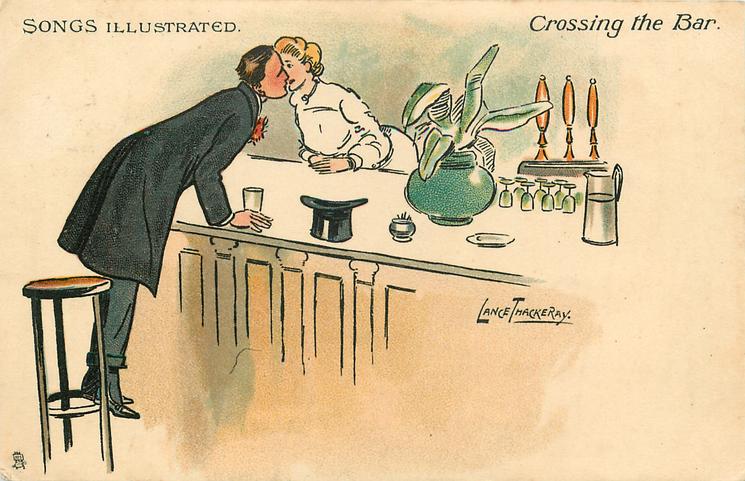
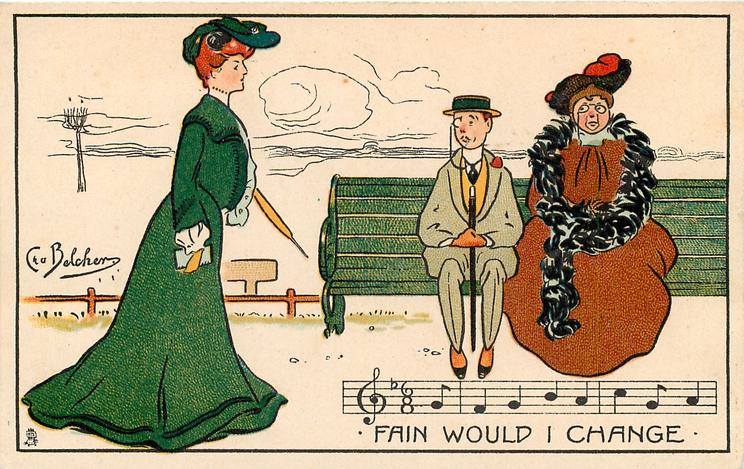
I really like these postcards.